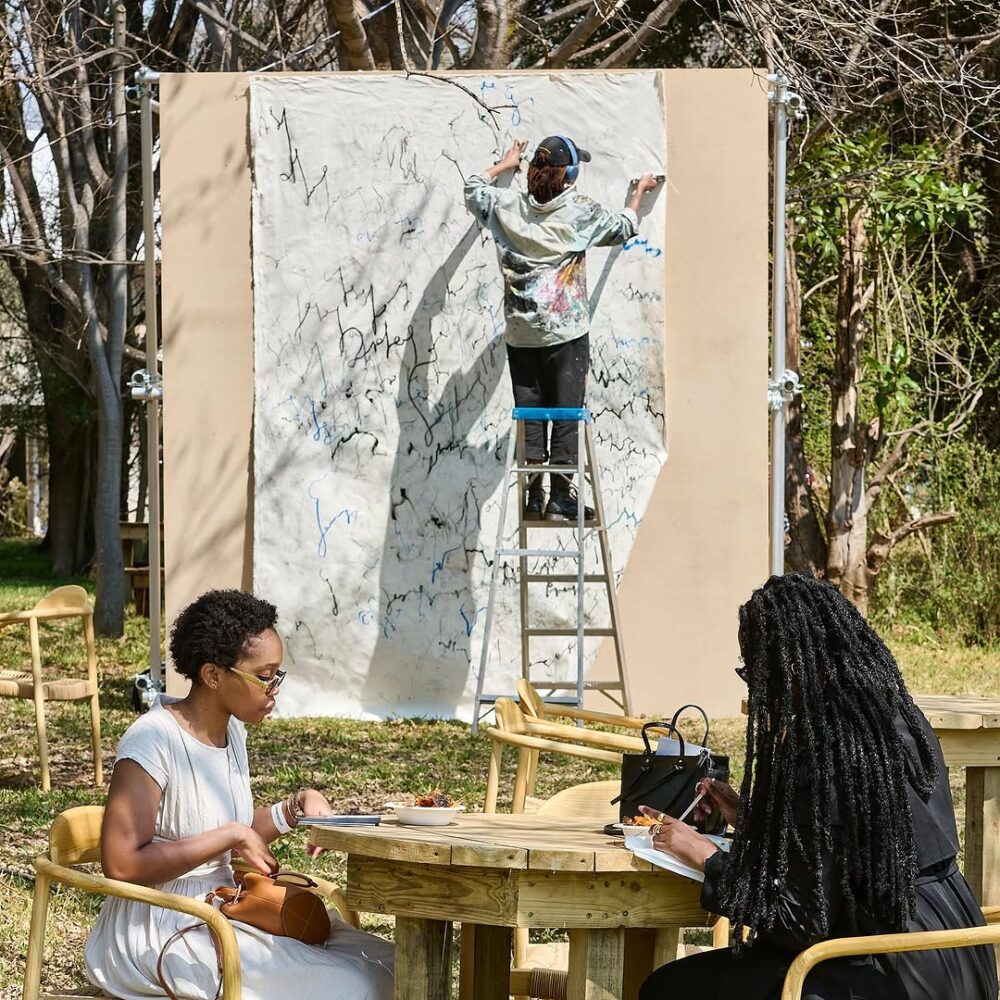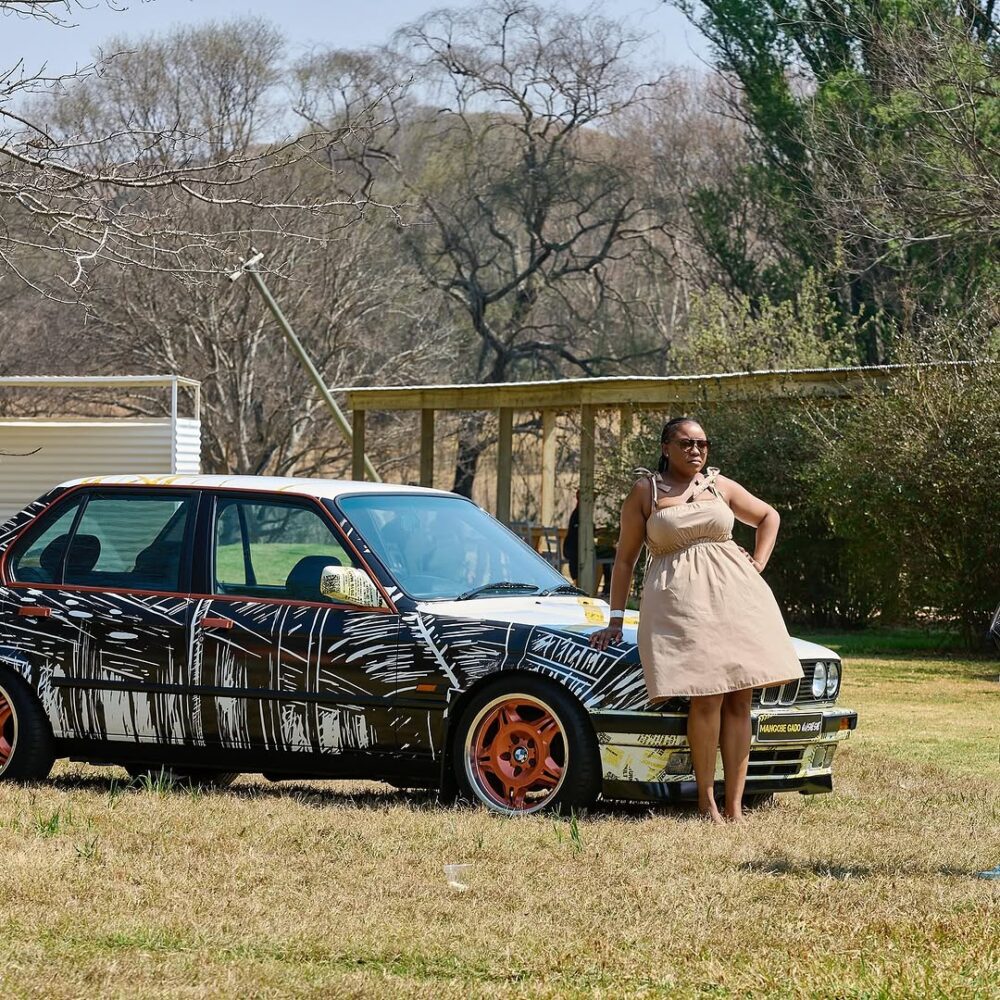Sculpture under the sun: A talk around Angus Taylor’s Morphic Resonance was held during the BMW Art Generation Vol III at Nirox Sculpture Park last weekend. Photo: BMW Group South Africa
On Saturday, 30 August, Nirox Sculpture Park was transformed for the third edition of the BMW Art Generation.
While the park, outside Joburg, is known for its polished events, this time its sprawling, nature-first landscape was taken over for this well-loved gathering, part music and art festival, part society day out.
The official theme, “A Tropology Between Image and Imagination”, suggested lofty ambitions, yet the mood on the ground was playful — a space where art was only one ingredient in a wider composition of easy communal energy.
As our guide, Tristin Roland, led us through the grounds, drawing attention to Willem Boshoff’s Stone Circle and Jerusalem Jerusalem: The Wailing Wall (2017); Ayana V Jackson’s Faux Cul VI–X (2017–18); Xhanti Zwelindaba’s Truth and Reconciliation Commission: Apartheid’s Wishing Well (2017) and Angus Taylor’s Morphic Resonance (2014), one could sense that in this small group were people who were, to varying degrees, at least curious about art. They followed attentively, exclaimed at new knowledge and asked thoughtful questions.
But while Roland unpacked the works’ formal and conceptual frameworks, the general crowd seemed drawn elsewhere. The sculptures became points of improvisation, sparking spontaneous interpretations, with hilarious vernacular murmurs about “lamazinyo”, referring to Adelheid Frackiewicz’s toothy installation, emerging as playful readings that diverged entirely from the provided narratives.
At best, the works functioned as photo ops or humorous asides in and among unrelated conversations, demonstrating in real time how meaning is continually remade outside prescribed frames.
Soon, it became ever clearer that the art was no main event. Muneyi, the sultry Venda crooner, set the tone with a voice that called each ear from every corner of the park in a gentle opening performance that seemed at first to slow the pace.
But then the tempo quickened as more groups arrived, dressed to the nines and posing for photos in front of various BMWs that attracted more attention than the sculptures.
One thing was clear — affluence was the tone. Any signs of poverty were left back in the city. Women seemed to be floating on sunshine in their flowing maxi dresses, men in crisp linens and straw hats, each outfit a subtle flex. Even the children seemed to know their drip was part of the show.
Everywhere you looked: smiling, stylish people living their best lives.
Of course, there were hiccups. The food stalls seemed woefully underprepared — the paella stand had run out of paella by midday, though the event was set to end at six. Hunger panged, though the drinks flowed freely.
Schedules shifted without warning, leaving visitors to piece together the programme by word of mouth. And the whole thing carried a sense of blissful chaos.
Msaki’s set followed, pared down to violin, bass and guitar, moving with quiet precision amid the buzz of the crowd. Gospel-inflected refrains threaded through the performance and the audience, clearly familiar with her songs, responded with attentive warmth.
She closed with her hit Fetch Your Life, after recalling conversations with many fans who’d been encouraged by the song to take courageous leaps, like “opening that bakery”.
The talks, meanwhile, struggled to compete with the festival atmosphere, with no dedicated venue — panels were staged on the same platform as the music — conversations dissolving into the general din.

 Whatever revs your engine: People enjoyed activities at BMW Art Generation Vol III, including taking photos with the BMW models on display.
Whatever revs your engine: People enjoyed activities at BMW Art Generation Vol III, including taking photos with the BMW models on display.
Julie Nxadi, Kemang wa Lehulere, and Nicholas Hlobo did their best in their ambiguously, albeit aptly, titled talk Existence, Performance and Being, with Hlobo quipping, “The sense of being as a South African is a very curious and peculiar idea.
“The sense of our freeness is questionable because we are not free. I’ve come to realise there’s no freedom. Freedom is within you. It’s not out there. I’m a South African. It’s nice to be neighbourly. Being neighbours with people I could not be neighbours with (before). And being able to bonk them. There’s nothing wrong with that. Bonk is how life gets to manifest.”
A funny aside, sure, but drowned in the irreverent sound of libations and laughter. You got the sense that the audience hadn’t the faintest idea who was speaking, nor did they care.
Though I lamented the art’s eclipse, the park didn’t fail — not that it ever does — to shimmer with familiar faces. I traded words with Wa Lehulere and Hlobo in the VIP section, caught up with Zanele Muholi who, as always, moved with a loyal entourage, and noticed the subtle shift of attention when Thandiswa Mazwai arrived mid-set. I spotted Mandla Sibeko, director of FNB Art Joburg, alongside his wife, who, I learned, is Sipho “Hotstix” Mabuse’s daughter. To drift among these encounters, half gossip, half observation, was perhaps artful enough.
As anticipated, Hotstix, the headliner, closed the event with the funkiest flair. His set balanced nostalgia with musical sophistication, supported by a robust band, including longtime collaborators.
Ending with Burn Out, he had the crowd on its feet. An energising and perfectly fitting climax.
The event was a sure success. People were genuinely happy. So, who cares if the “art” part of BMW Art Generation took a back seat? In doing so, perhaps the event was fulfilling its own premise: “A Tropology Between Image and Imagination”.
This is where NoViolet Bulawayo’s novel We Need New Names (2013) feels uncannily relevant. She was writing about migration and the struggle to find language for fractured lives across borders but her provocation resonates here.
We inherit terms like “art” and “art world” as if they still describe what is happening in the here and now. But maybe they don’t. Maybe “art” in its old sense — cloistered contemplation, hushed audiences, reverence for discourse — no longer captures what an event like this has to become.
To insist on calling it by that name is to risk missing a generational reordering where social ritual eclipses traditional art objects and art talk.
If Bulawayo’s characters needed new names for their reshaped worlds, perhaps we need new names for our cultural activities. The BMW Art Generation is less about art in the canonical sense and more about collective performance, about making presence itself the medium. Call it community, call it swag, call it black joy. But to keep calling it “art” feels like forcing old wine into new skins.
Maybe that’s the lesson. If we want to understand this generation honestly, we have to stop misnaming it.
Maybe those of us who still pine for a disappearing “art world” are missing the point. What we saw this year was not an art generation so much as a vibe generation. And if that feels unserious, that’s because seriousness itself may no longer be relevant.
Maybe that’s exactly what makes this event work. Maybe it’s time we stopped calling it something else, and simply let it be what it is — just vibes.